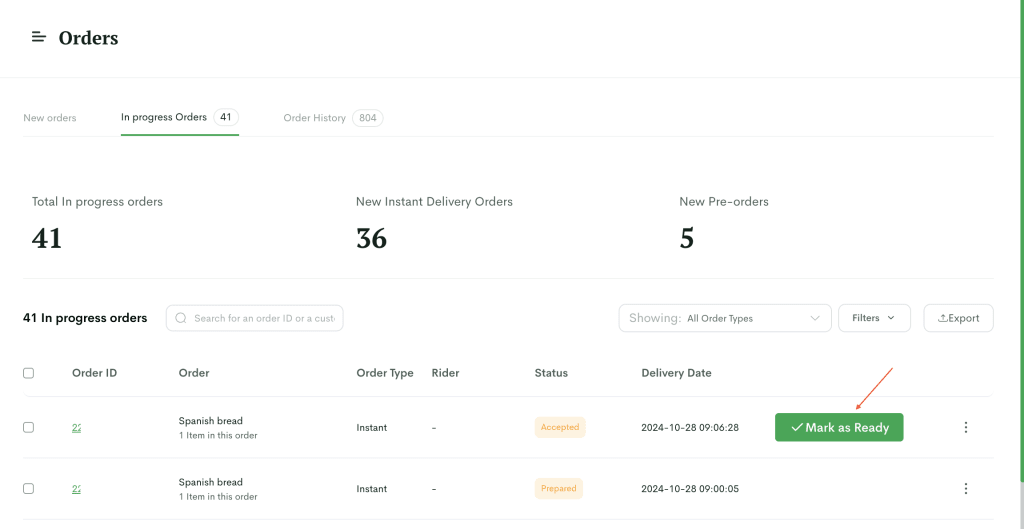Introduction
Running a successful business as a vendor involves more than just offering great products; effective order management is equally essential. On EdenLife Marketplace, vendors are given tools designed to streamline the order-handling process, ensuring that each customer receives their order accurately and on time. By following the correct procedures, vendors can enhance customer satisfaction, increase sales, and build a reliable reputation. This article will guide you through managing orders on Eden Marketplace, from the moment a customer places an order to the final handoff to delivery personnel.
Read: How to create a voucher as a Vendor on Eden marketplace
Receiving and Reviewing New Orders
How Orders Appear on the Vendor Dashboard
When a new order is placed, vendors receive an instant notification that pops up on their order list. This notification appears directly on the vendor dashboard, which you can access on your your Vendor mobile app on IOS or Android, if you don’t have it installed, download the app on iOS or Android, and you can also access the dashboard on the Marketplace Vendor Web. The order includes all essential details, such as the items requested, quantity, customer information, and any specific instructions provided by the customer. A well-designed dashboard keeps vendors organized, enabling them to respond promptly to each order.
Deciding Whether to Accept or Reject an Order
Not every order may be a perfect fit, and vendors on Eden have the flexibility to either accept or reject incoming orders. A decision to accept might be based on inventory availability, delivery capacity, or other factors impacting fulfillment. If rejecting an order, it’s essential to do so quickly to maintain a professional image and notify the customer early. Accepting an order locks in the vendor’s commitment to fulfill it within the stipulated time frame.

Managing Accepted Orders
Steps to Confirm an Order
Once an order is accepted, it’s crucial to confirm that all items are in stock and available for preparation. This step helps avoid any surprises later in the process. Confirming the order also triggers an update on the platform, alerting the customer that their order is being processed. At this point, vendors should pay attention to any specific instructions to ensure the customer’s expectations are met.
Marking an Order as Ready for Pickup
After preparing the order, the next step is to mark it as “Ready.” This status update notifies Eden’s logistics team that the order is complete and ready for delivery. A timely update is critical, as it ensures there are no delays in dispatching a rider to the vendor’s location.


Handing Off Orders to Eden’s Delivery Riders
What Happens After an Order is Marked Ready
Once an order is marked as ready for pickup, it transitions to Eden’s delivery network. A rider is assigned automatically, and the estimated time of arrival is provided to the vendor. It’s a hands-off phase for the vendor, but it’s important to stay prepared for a smooth handover when the rider arrives. Packaging the order securely and ensuring it’s labeled correctly will help avoid any mishandling during transit.

Ensuring Smooth Handover to Delivery Personnel
When the delivery rider arrives, they will verify the order details before taking possession of the package. As a vendor, it’s crucial to double-check that everything matches the customer’s request. Providing clear handover instructions and any relevant handling notes helps the delivery personnel execute the final leg of the journey with precision. A positive interaction during this phase contributes to the overall customer experience.
Best Practices for Order Management
Timeliness and Responsiveness
One of the key elements of effective order management is being timely. Vendors should aim to accept, prepare, and mark orders as ready without delay. A quick turnaround not only improves the likelihood of repeat customers but also ensures that deliveries are prompt, enhancing Eden Marketplace’s reputation as a reliable service.
Communicating Effectively with Customers
Clear communication can make a significant difference, especially if there are unexpected delays or changes. Use the customer’s phone number to keep customers informed about the status of their orders. Transparency builds trust and reduces the risk of negative feedback. Proactively notifying customers about any challenges goes a long way in maintaining a good relationship.
Conclusion
By embracing best practices, vendors not only enhance their operations but also contribute positively to the broader marketplace ecosystem. A well-managed order cycle results in happy customers, repeat business, and an ever-growing reputation on the platform.


